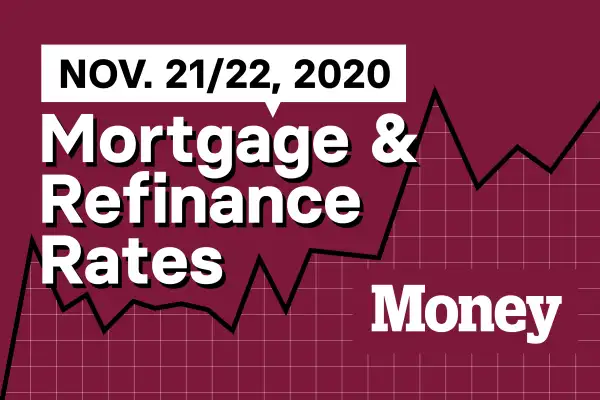Today's Best Mortgage and Refinance Rates for November 21 and 22

Mortgage rates set a new record low amidst rising coronavirus infections and a slowing economy. Buyer demand is still unseasonably high as existing home sales reached their highest level since 2006. Builder confidence also reached an all-time high as the outlook for 2021 remains positive
Today's Best Mortgage Rates
The average rate for a 30-year fixed-rate purchase mortgage was 3.201% on Thursday. The average rate for a 30-year refinance was 4.085%.
Money's most recent mortgage rates include data from over 8,000 lenders across the United States and are updated daily. These rates include discount points and represent what a borrower with a 20% down payment and 700 credit scores — roughly the national average FICO score — would have been quoted.
| Mortgage Rates for November 20, 2020 |
| Loan type | Average Rate |
| 30-Year Fixed Loan | 3.201% |
| 15-Year Fixed Loan | 2.423% |
| 30-Year FHA Loan | 3.142% |
| 30-Year VA Loan | 3.244% |
| 30-Year Jumbo Loan | 3.626% |
Source: Money | Date: Nov. 19, 2020 | Rates Assume a Credit Score of 700
Mortgage rates vary from state to state. On Thursday, borrowers in Illinois were quoted the lowest mortgage rates — at 3.047%. People looking for mortgages in Nevada saw the highest average rate at 3.37%. Nationwide, borrowers with the highest credit scores, 740 and above, were quoted rates averaging 2.867%, while those with credit of 640 or below were shown rates of 4.61% — a 1.743 percentage-point spread.
You may be able to negotiate a lower rate if you shop around or if you have other accounts with the lender. (Money's picks for the best mortgage lenders are here.) Currently, some lenders are hiking up advertised rates to keep demand in check, so you may be offered a lower rate if you reach out directly.
Freddie Mac's widely quoted Primary Mortgage Market Survey put rates at 2.72% with 0.7 points paid for the week ending November 19, a 0.12 percentage point drop from last week's 2.84% and the 13th record low set this year. The mortgage purchaser's weekly survey reflects borrowers who put 20% down on conforming loans and have excellent credit.
Today's Best Refinance Rates
Money's most recent survey also shows that the offered rate for a 30-year refinance for someone with a 740 credit score was 3.338% on Thursday. Last November, the average mortgage rate (including fees) was 3.874%.
| Refinance Rates for November 20, 2020 |
| Loan type | Average Rate |
| 30-Year Fixed Loan | 3.338% |
| 15-Year Fixed Loan | 2.756% |
| 30-Year FHA Loan | 3.532% |
| 30-Year VA Loan | 3.585% |
| 30-Year Jumbo Loan | 3.587% |
Source: Money | Date: Nov. 19, 2020 | Rates Assume a Credit Score of 740
A homeowner with a $200,000 mortgage balance currently paying 3.874% on a 30-year could potentially cut their monthly payment from $940 to $880 by financing at the current lower rates. To determine if it's worth it to refinance your mortgage, also consider the closing fees you paid on your current mortgage, how much your new lender is charging and how long you have left on your loan term. (Our picks for the best lenders for refinancing are here).
The Week in Review
Mortgage rates plunged this week. The average rate for the most qualified new borrowers dropped by .012 percentage points week-over-week, hitting a new record low of 2.72%, according to Freddie Mac. It's the 13th time this year that interest rates have set a historic low. The drop came as a result of economic uncertainty amidst a resurgence of COVID-19 infections across the nation.
However, there was some good news on the pandemic front, as drug-maker Moderna announced that its vaccine had an effective rate of 94.5%. It is the second vaccine in two weeks to show promising results. Pfizer has also announced their vaccine was 95% effective against the virus. A vaccine that could become available sooner rather than later would help stabilize the economy and improve overall employment, making homeownership more accessible.
According to a recent Redfin survey, 26% of homeowners say they would move from their current location to a different area or would reconsider the area they were thinking of moving to, because of the way their local government has responded to COVID-19. By contrast, 21% of respondents said the way their government dealt with the pandemic made them like the place they live.
People are also keeping away from big cities. Over 50% of respondents said they would be uncomfortable moving to a large city with a high population density compared to 39% prior to the pandemic. Other reasons why homeowners said they are interested in moving are the local school shutdown policies, as well as the political affiliation of the local residents. Forty-two percent said they would be hesitant to move to an area where they would be in the political minority
Builder confidence continues on the rise, as the National Association of Home Builders/Wells Fargo Housing Market Index increased five points to 90, a new all-time high. The index, which measures builder confidence in the newly-built, single-family home market, has been setting new records for the past three months. Year-to-date, new home sales have increased by almost 17% in 2020, spurred by historically low mortgage rates, a tight housing inventory, and high demand for suburban homes. A score greater than 50 indicates that builders view conditions in the housing market as being positive rather than poor for the next six months.
There’s more hope for a more balanced relationship between supply and demand for the upcoming year as new housing starts reached a seasonally adjusted annual rate of 1.53 million for the month of October, according to the U.S. Census Bureau, the highest rate since February. It marks the second straight month of increases in the number of starts and represents a 14% year-over-year increase. Single-family homes made up the largest share, with 1.179 million units, the highest level since 2007. This is positive news for an industry that has been low on supply since well before the pandemic and bodes well for an improved balance between supply and demand for 2021.
By contrast, starts for buildings of five units or more were at an annual rate of 334,000. Interest in multi-family construction has dropped as buyers seek more spacious homes and more social distance from neighbors.
Sales of existing homes reached a seasonally adjusted rate of 6.85 million units during the month of October, according to the National Association of Realtors. That's a 4.3% increase over September and almost 27% above October 2019. It's also the highest level since February of 2006. Sales for single-family units were at an annual rate of 6.12 million, up 27% from a year ago. By contrast, sales of condos and co-ops were at an annual rate of 730,00 units.
Gains were seen across all regions with the Midwest posting the largest monthly increase, up 8.6% to an annual rate of 1,640,000. The Northeast followed with an increase of 4.7% to an annual rate of 900,000, followed by the South with a 3.2% increase to 2,910,000 units, and the West with a 1.4% increase to 1,400,000 units.
The median existing-home price for all housing types rose to $313,000 compared to $271,000 last October. Home prices have increased for 104 consecutive months.
Inventory, however, continued on a downward trend. There were a total of 1.42 million unsold units available for sale at the end of October, down 2.7% from September and nearly 20% from last year. At the current pace of sale inventory is at an all-time low of 2.5 months supply. Last October there was a 3.9 month supply.
Inventory received a little bit of a boost as home sellers returned to the market. According to Realtor.com, new listings were down 7% year-over-year for the week ending November 14, an improvement over the 12% deficit from the week ending November 7. The recent trend has been for a worsening in the housing supply. The slight improvement in new listings could be a sign of an improving supply or could be just a temporary blip. The total housing inventory remained at 38% below last years' supply for the fifth consecutive week.
Meanwhile, median list prices were 12.6% higher year-over-year. The pace of sales remained steady with homes selling about two weeks faster on average than in 2019.
According to the Mortgage Bankers Association, the total number of mortgage applications decreased slightly for the week ending November 13, down 0.3% thanks in large part to a reduction in the number of refinance loan applications. Refinances were down 2% week-over-week, but still 98% higher than the same time last year and accounting for almost 70% of all loan applications. Purchase loans, which had been trending downward for the last few weeks, were up 4% week-over-week and 26% year-over-year.
More borrowers continue to exit forbearance plans than enter it, according to the MBA. The overall share of loans in the program decreased by 20 basis points to 5.47%. There are an estimated 2.7 million homeowners remaining in the payment deferral programs.
The decline was across all loan types, led by portfolio and private-label securities, which decreased by 32 basis points, followed by Ginnie Mae loans with a 25 basis point drop, and Fannie Mae and Freddie Mac loans with a 13 basis point decline. Of those homeowners who remain in forbearance, 76% are in an extension as the original six-month period has expired.
Of the borrowers who have exited the program, 30% left having made their monthly payments on-time. Another 24% resulted in a loan deferral/partial claim and 17% were loan reinstatements where the homeowner paid back all past due amounts prior to their exit.
Initial unemployment claims came in higher than economist's expectations as new claims totaled 742,000 for the week ending November 14. Expectations had been for claims to total 710,000. The four-week moving average was also 742,000, down from last week's 755,750. The insured unemployment rate decreased by 0.3 percentage points to 4.3%. The number of people claiming benefits from all unemployment programs was 20,319,615. Last year, there were 1,476,521 people claiming benefits.
More from Money:
Finding a Home Is so Hard Right Now That Buyers Are Scouring Obituaries and Divorce Notices
Lockdown Converted Many Americans Into Serious Savers. Now They Have Houses to Show for It
The 10 Most Affordable Suburbs in America
Rates are subject to change. All information provided here is accurate as of the publish date.
